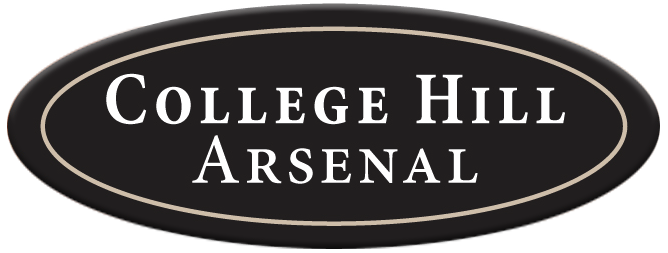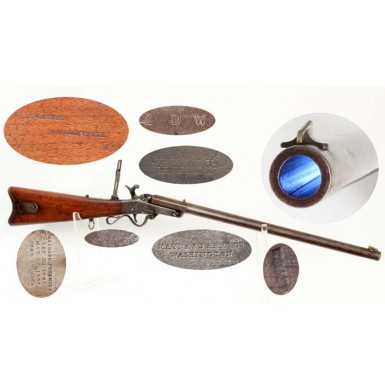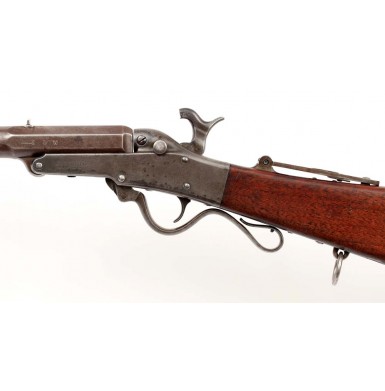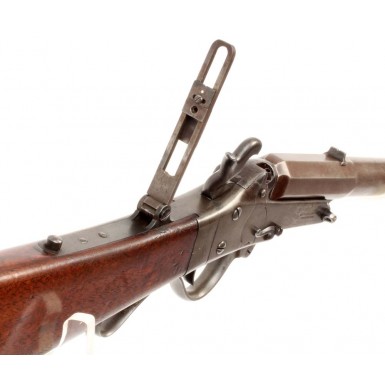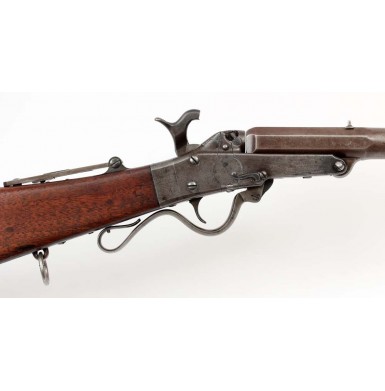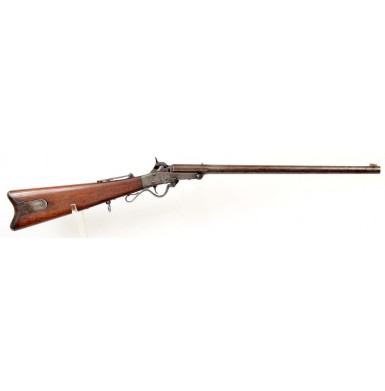1st Model Maynard Carbine in CS Purchase Range
- Product Code: FLA-2088-SOLD
- Availability: Out Of Stock
-
$0.00
McAulay further notes that approximately 90% of this remaining inventory of 1st Model Maynard rifles and carbines were purchased by southern states and militia companies between October 1, 1860 and April of 1861. McAulay’s research indicates that the majority of the guns went to the states of Mississippi, Florida and Georgia. According to his figures, Florida acquired a total of 1,030 guns in December of 1860, all of which were carbine length (20”) and were chambered in .35 caliber. Mississippi acquired 800 guns in December of 1860 as well. Their purchase included both carbines (625 total) and rifles (26” barrel, a total of 175) and the guns were a mixture of .50 and .35, with all 175 of the rifles and 300 of the carbines being .50 and the remaining 325 carbines being .35. All 650 of the Georgia purchased guns were all .50 caliber carbines. While Florida and Mississippi acquired their guns directly from the Massachusetts Arms Company, Georgia purchased their guns in January and March of 1861 from the firm of W.J. Syms & Brothers of New York City. Syms sold an additional 1,700 Maynards between October 1860 and May 1861. It is estimated that all but about 100 of these guns went to southern purchasers. McAulay notes that approximately 800 of these guns went South Carolina and Louisiana. The balance of the estimated 800 “Confederate” sales by Syms were apparently made to Kentucky and Tennessee in April and May of 1861. A substantial number of Confederate regiments were at least partially armed with 1st Model Maynard rifles and carbines during the Civil War, resulting in the guns (n both barrel lengths and calibers) being listed in the 1863 Confederate Ordnance Manual as a standard issue Confederate carbine. Some of the Confederate units armed with the guns included the 1st and 6th Florida Special Battalion of Infantry, 2nd Florida Cavalry, 5th & 9th Georgia Cavalry, Cobb’s Legion of Cavalry (Georgia), 1st Louisiana Cavalry, 11th Louisiana Infantry, 1st & 4th Mississippi Cavalry, 9th, 14th & 15th Mississippi Infantry, 18th North Carolina Infantry, 3rd Tennessee Cavalry, 35th Virginia Cavalry Battalion and the Waccamaw South Carolina Light Artillery. Some 1st Model Maynards were also issued to the Confederate ironclad CSS Atlanta. The production of the 1st Model Maynard was brought to an end by a fire at the Massachusetts Arms Company factory in January of 1861. Dr. Maynard proceeded to buy out all of the various partners and owners of the company in 1862 and by 1863 the factory was back in business, producing the 2nd Model Maynard Carbine for the US Ordnance Department.
This 1st Model Maynard Carbine is in about VERY GOOD+ to NEAR FINE condition overall. The gun is a 20” barreled, .50 caliber, military configuration carbine. This makes it one of the 676 military .50 carbines on hand at the Massachusetts Arms Company on October 1, 1860. Based upon Confederate purchase records, this gun was almost certainly sold to either Mississippi or Georgia. Since Georgia purchased roughly twice as many .50 carbines than did Mississippi, the gun is twice as likely to have gone to there. The gun is 100% complete and correct, with the exception of a single replaced screw in the bottom of the frame and what appears to be a period added Rocky Mountain style German silver sight blade in the original front sight. The gun is mechanically excellent and fully functional in every way, including the somewhat temperamental Maynard Tape Priming System. The action of the carbine remains crisp and tight, with solid and secure lock up. The carbine is clearly marked in two lines on the lower right side of the frame: MAYNARD ARMS CO. / WASHINGTON. It is additionally marked on the lower left side of the frame: MANUFACTURED BY / MASS. ARMS CO. / CHICOPEE FALLS and on the patchbox door: MAYNARD PATENTEE / SEP 22 1845 / MAY 27 1851 / JUNE 17 1856. The paper Maynard label is missing from the inside of the patchbox, but the wood of the patchbox is stamped with the name WHITE. The carbine is serial number 2090 and is clearly marked with that number inside the tape primer door and on the bottom of the barrel (concealed by the frame).
The gun is additionally marked with the initials Z D W on the left side of the octagonal breech. The meaning of these initials is more clearly revealed by the three line identification, stamped on the reverse of the buttstock, which reads: Z D WATER / BROOKEVILLE / MD. From the research that I have been able to do, it appears that Z D WATERS was Zachariah D. Waters of Brookeville (Montgomery County), Maryland. Zachariah D. Waters was born in 1809, the son of Basil Waters and Anne Pottinger Magruder (daughter of Revolutionary War hero Zadok Magruder). Basil and Anne married in 1799 and their home in Germantown (Montgomery County), Maryland is the oldest surviving home in this town. Zachariah was the youngest of six children, and upon his father’s death he inherited the home and 656 acre plantation. According to the Federal Government publication: List of Post Offices in the United States with the Names of Postmaster on the 1st of July, 1855, Z.D. Waters was the postmaster of the Brookeville, MD post office in 1855. Brookeville is located about 13 miles due east of Germantown. Since the position of Post Master was essentially a position of political patronage during the 19th Century, it is likely that Waters had been a political supporter of Franklin Pierce, who was the 14th President of the United States, serving from 1853 to 1857. Although Pierce was from New Hampshire, he was known as a “doughface”, a Northerner with Southern sympathies. I have not been able to locate any record of Waters serving in the Confederate (or Union) army. How Waters came into possession of the carbine is not known. He might have obtained it after the war or possibly during the war. Some units that were issued these carbines would have passed through Montgomery County Maryland during the course of the war (especially during the Antietam and Gettysburg campaigns), and Waters could well have obtained the carbine from one of those units “ possibly from a wounded soldier seeking refuge in his plantation home. No matter how he came into possession of the carbine, the name clearly indicates that this gun was likely in service in the very heart of some of the most contested territory during the course of the war, and could well have been obtained from a member of Cobb’s Legion of cavalry, which operated in the area during the Gettysburg campaign. Some 28 men with the last name “White” served in Cobb’s Legion during the war, increasing the possibility that this was where the carbine was acquired.
As previously noted the gun is in lovely, crisp condition. The frame retains some light traces of color case hardening. Most of which has faded and blended to a smoky gray patina. There is some light peppering and minor pinpricking around the breech area and near the percussion bolster, all from the caustic mercury in the primer pellets. The original cone (nipple) is in place, although it does show some significant wear and some minor chipping along the edge. There is a tiny crack in the side plate of the carbine, located immediately below the hammer and to the rear of the tape primer door. This area is very thin and weak and prone to breakage. The crack is minimally noticeable and does not materially affect the display of this really lovely carbine. The barrel retains only some minor traces of blue in the protected areas under the breech. The balance of the 20” octagon to round barrel is a light plum-brown patina, over smooth gray base metal. There are some small, scattered patches of minor peppering and pinpricking along the length of the barrel. There are also some scattered patches of slightly darker age discoloration mixed with the plum-brown patina. The large rounded buttplate and patchbox both have a mixed plum brown and gray patina as well. The gun is in the “military” configuration and is equipped a 1” sling ring on the rear of the trigger plate tang. It also has the military sight package, which included both the flip up, long-range tang sight and the fixed “quick acquisition” rear sight on the breech of the barrel. The fixed sight was calibrated for a 200-yard point of aim. The original front sight is present, but has been modified by the addition of a Rocky Mountain style German silver sight blade. This appears to be a period modification, which would have significantly improved the long-range accuracy of the carbine. The bore of the carbine is in FINE+ to NEAR EXCELLENT condition. The bore is bright and retains fine, crisp rifling. The bore shows only some light to moderate scattered frosting in the grooves, and some minor pitting towards the muzzle of the carbine. One of the unique features of the 1st Model Maynard carbine was the ability to adjust the headspace of the gun, by adjusting the relationship between the barrel breech and rear of the frame. This was accomplished by the means blocking wedges which could be moved slightly by turning two screws located it the bottom of the frame, forward of the trigger guard. The rear most of these screws is a non-period replacement, but fits well and functions as it should. This is the only component of the gun that I have found that is not from the period of use. The buttstock is in VERY FINE+ to NEAR EXCELLENT condition. The stock is solid and free of any breaks, cracks or repairs. The buttstock shows the usual minor bumps and dings from handling and use, but shows no abuse or damage.
Overall this is a really wonderful, complete and extremely attractive example of a 1st Model Maynard Carbine. The gun is in fine mechanical condition, has a great bore and is as complete correct and original as one could hope to find. With only a single replaced screw, this gun really does qualify as “unmolested and untouched”. The gun is in the most desirable of all 1st Model Maynard configurations, the .50 caliber, military carbine. The gun is almost certainly a Confederate purchased arm and either went to Mississippi, or most likely Georgia. 1st Model Maynard carbines do not appear on the market very often, and when they do the price usually starts in the $5,000+ range and quickly climbs. This is a great looking carbine with an interesting period ID that is worth investigating, and is a carbine that you will be very proud to add to your collection. I am very sure that you will be very happy with this great example of a 1st Model Maynard Military Carbine.
SOLD
